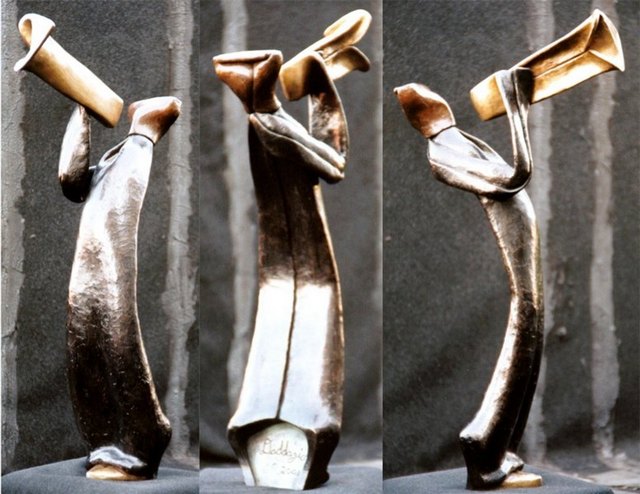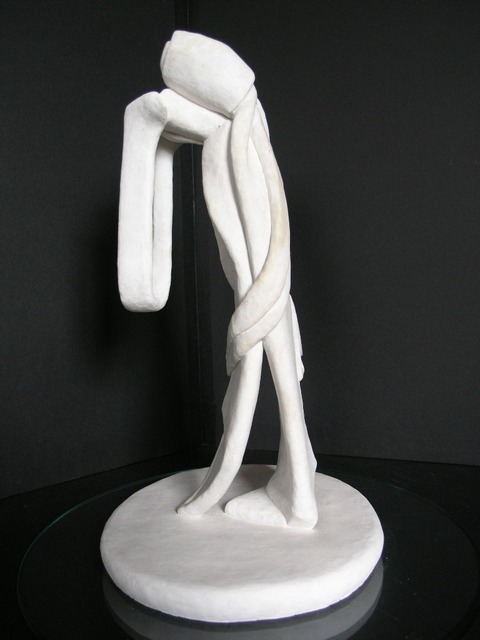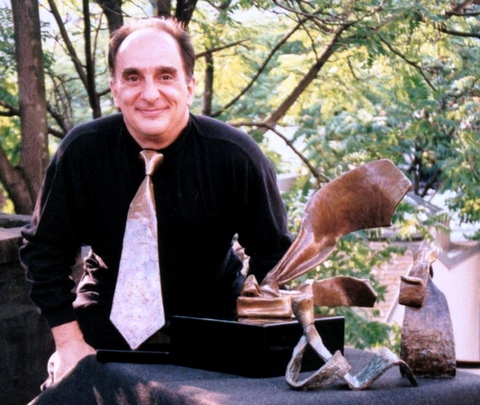|
The cravat originated in Croatia during the 1600’s
Nicholas B. Daddazio is the first sculptor to create figurative and representational bronze sculptures of the cravat since its origin in Croatia during the 1600's  Cravat Trumpet, bronze - 3’ (1 m)
Nicholas B. Daddazio - Artist Bio
Nicholas B. Daddazio is a graduate of the University of Buffalo and studied sculpture in New York as an apprentice to legendary sculptor Domenico Facci, working in the Facci Studios for nearly a decade. In 1992, Daddazio opened his own studio at Pietrasanta Fine Arts in Soho, where he continued making figurative sculpture and commenced an intensive study of the cravat as symbol and icon. His study of the cravat resulted in the production of a large collection of bronze cravat sculptures: Reclining Cravat; Cravat Saxophonist; Cravat Ballerina; Cravat Geisha; Representational Stripe, Buff, Textured; Cravat Trumpet; and many others. In 1994, The Neckwear Association of America commissioned Daddazio to design the trade organization’s new awards trophy, a commission that ran for nearly ten years until the NAA closed its doors. More commissions followed, along with many one-man shows and exhibits and the establishment of the Cravat Sculpture and Art Gallery in 1996 on Cornelia Street in Greenwich Village.
Burlap and Denim Cravats on Steel Stands
In November 2005, Daddazio started making giant cravat sculptures ranging in length from four feet to nine feet in a variety of mixed media: awning canvas, cotton drop cloth, black plastic garbage bags, denim, bubble wrap, orange plastic fencing, orange and blue netting, blue poly tarp, and exquisite furniture fabrics. The artistic expression covers a range from Pop Art to Minimalism to Abstract
Nicholas B. Daddazo and Marijan Gubić, Croatian Consul General-NY,
at Ana Tzarev Gallery-NYC- Croatian Independence Day Celebration-June 2010
Expressionism to Realism, and the Nude. The giant cravats can be displayed on walls, in corners, on doors, along a staircase, hung from the ceiling, or flung over a bed, piano, or couch. Daddazio’s sculptures are in the private collections of Ralph Lauren, Tommy Hilfiger, The Versace Estate, Jhane Barnes, Kenneth Cole, the President of Brooks Bros., The Forbes Brothers Private Collection, and many others.
The cravat originated in Croatia during the 1600’s, and the first sculptor to create figurative and representational bronze sculptures of the cravat since that time is Nicholas B. Daddazio.
Nicholas B. Daddazio STUDIO DADDAZIO 31 Cornelia Street New York, N.Y. 10014
Tele: 212.645.6942
|  Greenwech Village open exhibition of cravats Nicholas Daddazo on the right with Ivana Živković Mikec, Croatian Consul Councelor, and Marijan Gubić, Croatian Consul General, New York - Studio Daddazio, Greenwich Village, NYC Mr. Nicholas B. Daddazio with his cravat sculputres at the Embassy of the Republic of Croatia in Washington.
Nicholas B. Daddazio - Artist Statement
Cravat Sculpture as icon and symbol of Western Culture is an unending subject of interest for me to explore. In 1991, my search for a new and surprisingly unusual, offbeat, out of the ordinary, and unexpected subject for my art led me to the ubiquitous cravat. The cravat was bold, beautiful and everywhere, not as sculpture, though, rather as fashion statement and accessory. The whole world could recognize the cravat in an instant, and in reality it was the most ubiquitous icon of the West. Forbes even promotes the cravat as a Capitalist Tool! The overwhelming meaning and importance of the cravat remained "submerged" in significance for more than one hundred years in the clutter of our culture.
Cravat Bronze Sculpture, Nicholas B. Daddazio, Sculptor
Ana Tzarev Gallery - NYC - Croatian Independence Day Celebration June 2010
Deep within our mindset was the concept of the cravat as a necessary colorful piece of fabric that brings elegance or meaning to your appearance. The psychological protection expanded over time, beneath the surface of every-day consciousness. The cravat was present, religiously, on the body and not in the form of a bronze sculpture or constructed gigantically in different media and exhibited on a wall. To make the transition, to transform, and to displace the ever-present cravat from its very familiar location so that it is out of "context" and re-born into a form of urban primitive art was a challenge worth pursuing.
Mr. Daddazio's cravat in Bar Pitti, Greenwich Village, NYC
Exploration began in wax, plaster, wire, and clay models. Of all the models that were made, three emerged which laid the foundation for Cravat Sculpture: Reclining Cravat, Cravat Ballerina, and Cravat Saxophonist. Molds were made for all three pieces that were subsequently cast into bronze using the Lost Wax Method. Many more bronze cravat sculptures followed in the form of representational and figurative pieces, and they were cast in Limited Editions, Open Editions, or unique (one-of-a-kind) sculptures.
Exhibition of cravat sculptures in Croatian Embassy in Washington, May 2010  Cravat Kiss - Plaster Maquette
As output continued in classic bronze, another form of cravat sculpture emerged in November 2005: Mixed Media Cravat Sculpture. The average height of the pieces was six feet, and they were made in bubble wrap, awning canvas, burlap coffee sacks, black garbage bags, blue poly tarp, canvas drop cloth, orange fence, blue and orange netting, fish net, denim, and furniture fabric. The Mixed Media pieces were "sculpted" with objects, constructed, painted on, and hot-glued together. Both classic Bronze Cravat Sculpture and Mixed Media Cravat Sculpture form the basis of my art and a framework for me to continue my study of the cravat as symbol and icon of the West.
Nenad Bach with bronze cravat at Ana Tzarev Gallery, New York  Nicholas B. Daddazio wearing bronze cravat
| Formated for CROWN by prof.dr. Darko Žubrinić
Distributed by www.Croatia.org . This message is intended for Croatian Associations/Institutions and their Friends in Croatia and in the World. The opinions/articles expressed on this list do not reflect personal opinions of the moderator. If the reader of this message is not the intended recipient, please delete or destroy all copies of this communication and please, let us know!
|